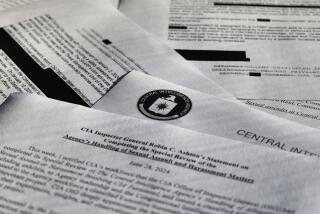Secrecy, turf wars hinder intelligence agencies
- Share via
When Khalid Almidhar and Nawaq Alhamzi arrived at Dulles International Airport on Sept. 11 to board American Airlines Flight 77, airline officials were unaware their names were listed on an Immigration and Naturalization Service watch list of people associated with possible terrorist activity.
That list, intelligence sources say, wasn’t available to the Federal Aviation Administration, which could have given the names to airlines and perhaps prevented the pair from hijacking the plane and crashing it into the Pentagon.
For decades in Washington, lists of people and information on suspects, targets and even terrorists have been held like state secrets, studied only by the agency that created them. But now, as the newly appointed director of homeland security, Tom Ridge, calls for an end to turf wars, intelligence and law enforcement agencies are struggling to meet the mandate that they learn how to share.
Since Sept. 11, that cooperation has become a matter of urgency, and things are changing.
“We follow every lead,” President Bush said at his news conference Thursday night. “And information sharing between the CIA and the FBI is seamless so that the reaction to any threat is real-time.”
After the hijackings, the FBI began disseminating detailed lists of persons suspected of terrorist activities to the airlines. Some of the lists contained detailed information such as addresses, Social Security numbers, birth dates and credit card numbers. Other lists were just columns of names.
While FAA officials will not discuss their security procedures, obtaining such FBI lists is a departure from past practice, said Mary Schiavo, former inspector general of the Department of Transportation and special assistant to the attorney general.
“Federal agencies such as the FAA depend on databases they receive from law enforcement agencies to compile lists of people the government is either looking for or wants to prevent from flying. Before Sept. 11, many of those lists never made it that far,” she said.
“These databases are not supposed to be secretive, but unless agents are specifically looking for someone, the FBI is not going to be combing the INS’ lists. And if the INS knows someone has overextended their visa, that information isn’t going to make it to law enforcement agencies. Coordinating intelligence data is very difficult. It hasn’t been done.”
Beyond concerns over privacy and security, agencies such as the National Security Agency, U.S. Customs Service, CIA and FBI are faced with reversing years of separatist thinking and interagency rivalries, as well as a vast computer networking problem: Agencies have each created hundreds of different databases and software programs that computer experts say simply aren’t compatible.
“Do we have the ability to teleconference, e-mail, get into each other’s databases? No,” said retired Rear Adm. Tom Brooks, former director of Naval Intelligence, one of 13 intelligence agencies including the NSA, CIA and FBI. “What would happen frequently is an analyst at [NSA] and an analyst at the Pentagon or the CIA would all be working on the exact same thing and wouldn’t even know the other existed.
“These are big issues of trust as well as mechanical issues,” he said. “No one’s ever bought the equipment. I applaud [Ridge’s] efforts trying to give the horse something to drink, but we haven’t even led the horse to water.”
Much of the problem goes back decades when many of these agencies were formed and tasked with entirely different duties. NSA was instructed in the 1950s to eavesdrop and collect information but leave the analysis to other agencies. The process was quickly disregarded when agency officials determined they couldn’t pull targeted information from the airwaves without understanding what they were looking at.
The CIA, and the military branches meanwhile concluded they didn’t want to depend on others to collect the information they deemed important.
As the agencies became more self-reliant, different cultures and attitudes emerged: the CIA developed a reputation as the “Ivy Leaguers,” NSA is known as “the Techies,” the FBI are the cops.
The intelligence arms of the Navy, Army and Air Force, whose agents come from submarines, ground combat and flight school, are known for bringing a more military perspective while federal law enforcement agencies like the customs service and INS, considered a step removed from the sophisticated world of intelligence, are treated even more skeptically.
“Imagine trying to investigate drug cases in Colombia, and we can’t have access to information from inside the country from the FBI and other agencies,” said Jeffrey Smith, former general counsel to the CIA under the Clinton administration. “It’s like trying to do an investigation by looking in the rearview mirror.
“We will go back and look, and I know we are going to find lots of bits of information that had [the agencies] been able to connect together, would have created a mosaic” of the attacks Sept. 11.
In some instances, relations between federal agencies have improved in recent years. In 1995, Smith and his counterpart at the FBI were tasked with creating the first-ever, eight-member team of FBI and CIA agents to share information and resources on specific cases. It was a far cry from the days when FBI Director J. Edgar Hoover and CIA Director Richard Helms in the 1960s reportedly only met twice over the course of the decade their tenures coincided.
Gen. Michael V. Hayden at NSA said earlier this year he speaks with CIA Director George J. Tenet almost weekly.
The intelligence community also shares information over a 7-year-old classified, private Internet, called Intelink, and can share some data as well using the “Secret Internet Protocol Router Network.”
But Intelink has been slow to take off, and has been further hampered by suspicions that alleged spies Robert Hanssen and Brian P. Regan likely used it to glean information. The router network, additionally, is closed to law enforcement agencies, including even the FBI.
Problems between the agencies became the most apparent when federal officials tried to take inventory of the agencies’ systems under the threat of a Y2K computer problem -- and realized no inventory had ever been taken.
“We found thousands of different systems,” said John Spotila, administrator of information and regulatory affairs in the Office of Management and Budget in the Clinton administration. “It was difficult even knowing what you had to work with let alone trying to get these agencies working together with each other.
“There has never been a spirit of full disclosure,” Spotila said. “The Department of Justice makes a decision about what systems they want to use, meanwhile the FAA made a decision about what they want to buy and they probably didn’t have a single conversation with each other, and that’s not an easy thing to change.”
Even if the databases were open, he said his agency found most of them aren’t compatible with computer programs and software other agencies are using.
Some agencies are forbidden by law from revealing information about cases that are pending before grand juries, or providing information that would breach the privacy of individual citizens. Civil liberties groups are closely watching the possible changes that could open up a Pandora’s box of information and tracking systems of private citizens.
As Ridge took over his new post this week he said, “The only turf we should be worried about protecting is the turf we stand on.”
But even concerns over national security haven’t always stopped the separatism. FBI officials have long charged that alleged spy Aldrich Ames went uncaught for nine years because the CIA failed to tell the bureau they were tracking him as a spy.
“The natural tendencies in these agencies is to hoard information,” said Steven Aftergood, an intelligence analyst with the Federation of American Scientists in Washington. “There is intense turf consciousness and rivalries. It is one of the most outstanding issues and will be one of the most difficult issues to address.”
More to Read
Sign up for Essential California
The most important California stories and recommendations in your inbox every morning.
You may occasionally receive promotional content from the Los Angeles Times.










